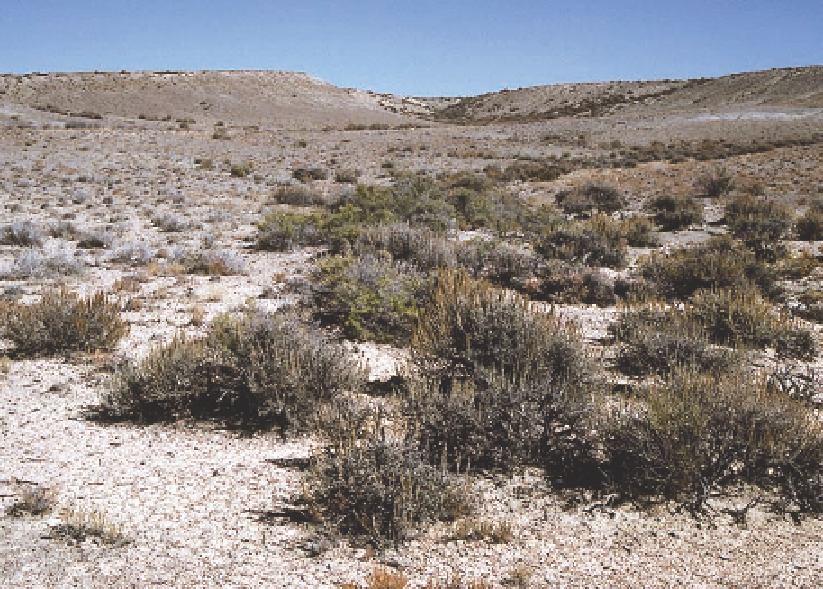Geoscience Reference
In-Depth Information
Fig. 8.6. Mixed desert
shrubland on the left, with
Wyoming big sagebrush in
ravines, near Green River.
elevation 6,500 feet.
tice that exposes selenium-bearing rock also increases
the density of plants that accumulate selenium. even-
tually, as leaves fall and the plants die, this selenium
is deposited on the soil surface, where it is subject to
redistribution by erosion. if this happens, toxic concen-
trations could develop in places where they would not
otherwise be expected.
Saltbush shrubland, sometimes called salt desert
shrubland, is dominated by Gardner's saltbush—a short
shrub also known as saltsage or nuttall's saltbush (fig.
8.8). Associated plants include birdfoot sagewort and
bud sagewort, both of which are species of
Artemisia
(see table 8.1). this vegetation type occurs commonly
on fine-textured soils developed from shale or alluvium.
in some areas the low shrubs are rare and the com-
munity appears more like desert grassland, with blue
grama common on somewhat sandier soils and western
shallow soils with relatively low salinity, the dominant
species may be bluebunch wheatgrass, needle-and-
thread grass, and several species of cushion plants (fig.
8.9; see table 8.1).
though its total biomass is low, Gardner's saltbush is
valued for the forage it produces on winter ranges, and
particles accumulate around shrubs, forming small
dunes (see fig. 7.9). Bud sagewort, galleta, greenmolly
summercypress, and Gardner's saltbush are common on
the drier desert pavement soils, whereas big sagebrush,
greasewood, Great Basin wildrye, indian ricegrass,
spiny hopsage, and thickspike wheatgrass are common
on the dunes. the coppice dunes apparently provide a
relatively moist and less saline environment. excessive
livestock grazing in deserts can promote the formation
of coppice dunes, as described for big sagebrush com-
munities in the previous chapter.
Further variation in desert shrublands, and in some
foothill shrublands as well, is caused by selenium—an
element required for proper animal nutrition, but it can
become lethal as concentrations increase. Some plants,
such as woody aster, princesplume, goldenweed, and
several species of milkvetch, accumulate selenium in
their tissues. the presence of these plants, known as
selenium indicators, has been used to map selenium-
rich bedrock, such as certain shales, siltstones, and
claystones that are carbonaceous or have high concen-
face mining and irrigation could increase the amount of
land where selenium accumulates to toxic levels in both
water and livestock forage, and even meat and plant

Search WWH ::

Custom Search